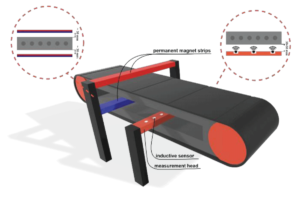Dimensioning of Splices Using the Magnetic System
Revolutionizing Conveyor Belt Diagnostics with the DiagBelt+ System
Conveyor belts play an indispensable role in industrial processes, ensuring efficient material transportation across diverse sectors. Yet, their durability and functionality rely heavily on the quality of belt splices—often the weakest point in conveyor systems. Diagnosing and maintaining the geometry of these splices has remained a technical challenge, but advancements like the DiagBelt+ magnetic diagnostic system are reshaping the way we approach belt maintenance.
In this blog, we explore the intricacies of belt splices, the innovative DiagBelt+ system, and its role in enhancing conveyor belt performance.
Understanding Belt Splices and Their Challenges
Belt splices are critical joints where conveyor belts are connected, making them both functional and vulnerable. Improperly constructed or maintained splices can lead to significant operational failures, resulting in production losses and expensive repairs.
Key challenges in belt splicing include:
- Ensuring Accurate Geometry: Variations in splice geometry can compromise strength and durability.
- Diagnosing Post-Vulcanization Errors: Once vulcanized, visual inspections are often insufficient for identifying structural anomalies.
- Avoiding Operational Failures: Undetected splice issues can cause cord separation and belt breakdowns.
The emergence of diagnostic technologies, such as the DiagBelt+, addresses these challenges with unprecedented precision.
 Figure 1: Schematic of connecting cords in a two-step splice.
Figure 1: Schematic of connecting cords in a two-step splice.
Introducing the DiagBelt+ Diagnostic System
Developed at the Wrocław University of Science and Technology, the DiagBelt+ diagnostic system has been successfully deployed in demanding environments like the Bełchatów Lignite Mine in Poland. The system employs advanced magnetic diagnostics to assess belt splices’ geometry and detect potential damage.
How It Works
The system utilizes the magnetic properties of steel cords embedded in conveyor belts. Pre-magnetized cords are scanned using a measuring head equipped with 90 inductive coils. Changes in the magnetic field, caused by splice irregularities or cord damage, are recorded and analyzed.
Key Components of DiagBelt+:
- Measuring Head: Houses the magnetic coils that detect field changes.
- Conditioning Bars: Magnetize the steel cords for precise diagnostics.
- Tachometer: Monitors belt speed.
- Data Acquisition Module: Transmits data to analytical software.

Figure 2: Schematic of the installation of the DiagBelt+ diagnostic system on a conveyor belt.
Benefits of DiagBelt+
- Early Damage Detection: Identifies structural anomalies before they escalate into failures.
- Enhanced Maintenance Planning: Provides actionable insights to extend the lifespan of conveyor belts.
- Cost Savings: Reduces unplanned downtime and repair costs.
Practical Applications of DiagBelt+
Field trials of the DiagBelt+ system have demonstrated its efficacy across a range of belt conditions. For example:
- Real-Time Geometry Assessment: The system accurately measures splice lengths and skewness coefficients, enabling immediate corrections.
- Damage Visualization: Figures 3 and 5 from the original study illustrate how DiagBelt+ identifies both symmetrical and asymmetrical splice errors, as well as cord damage.
These insights are invaluable for industries reliant on uninterrupted material transport.
 Figure 3: Examples of signals from two-stage skewed belt splices along with the determined geometry.
Figure 3: Examples of signals from two-stage skewed belt splices along with the determined geometry.
Enhancing Splice Geometry with Standards
Industry standards such as PN-C-94147:1997 and EN-ISO-1120:2012 provide guidelines for constructing belt splices. However, compliance with these standards is not always sufficient to prevent failures. Diagnostics like DiagBelt+ offer a proactive approach to ensure:
- Symmetrical cord alignment.
- Consistent splice lengths.
- Optimal skewness coefficients.
Case Study: DiagBelt+ in Action
At the Bełchatów Lignite Mine, DiagBelt+ successfully diagnosed several conveyor belts, identifying both manufacturing and operational defects. The diagnostic process revealed:
- Irregular cord alignment in multi-step splices.
- Minor damages that, if left unaddressed, could lead to major failures.
This proactive approach reduced the mine’s operational disruptions and extended the service life of its conveyor belts.
The Economic Impact of Splice Failures
The cost of a single splice failure extends beyond repair expenses. It includes:
- Production Downtime: Halts in material transport disrupt entire operations.
- Replacement Costs: Fabricating and installing new splices is resource-intensive.
- Safety Risks: Unreliable splices increase the risk of accidents.
By employing diagnostic tools like DiagBelt+, industries can mitigate these risks, ensuring both operational efficiency and safety.
Future Directions in Belt Diagnostics
The success of DiagBelt+ highlights the potential for integrating advanced technologies into conveyor belt diagnostics. Future advancements may include:
- AI-Powered Predictive Analytics: Leveraging machine learning to anticipate failures.
- Remote Monitoring: Enabling real-time diagnostics from centralized locations.
- Eco-Friendly Practices: Enhancing belt durability to reduce material waste.
Conclusion
The DiagBelt+ system represents a significant leap forward in conveyor belt diagnostics. By enabling precise assessment of splice geometry and early detection of damage, it ensures higher reliability, lower operational costs, and extended belt lifespans. For industries reliant on conveyor systems, embracing such innovations is not just an option—it’s a necessity.
References
- Błażej R, et al. Dimensioning of Splices Using the Magnetic System. IgMin Research. PDF.
- DOI: 10.61927/igmin204.
FAQ’s
What is the DiagBelt+ system?
The DiagBelt+ system is a diagnostic tool developed to assess the geometry and condition of conveyor belt splices using magnetic field analysis.How does DiagBelt+ detect splice damage?
It uses pre-magnetized steel cords in the belt and a measuring head with inductive coils to record changes in the magnetic field caused by irregularities or damage.What are the benefits of using DiagBelt+?
DiagBelt+ helps in early detection of damage, accurate splice geometry assessment, reduced downtime, and extended belt lifespan.Where has DiagBelt+ been implemented?
It has been successfully implemented at the Bełchatów Lignite Mine in Poland and other industrial sites for conveyor belt diagnostics.Why is diagnosing belt splices important?
Proper diagnostics prevent costly failures, ensure operational efficiency, and maintain safety by detecting hidden defects in belt splices.
